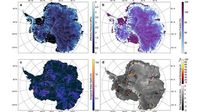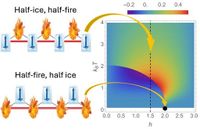In a groundbreaking discovery, physicists at the U.S. Department of Energy's Brookhaven National Laboratory have unveiled a new phase of matter, termed "half ice, half fire," within a model system of a magnetic material. This unprecedented state showcases a unique pattern of electron spins, comprising a mixture of highly ordered "cold" spins and highly disordered "hot" spins.
The discovery was detailed in the December 31, 2024, edition of the journal Physical Review Letters, authored by physicists Weiguo Yin and Alexei Tsvelik. This significant finding could potentially revolutionize various fields, including energy and information technology, by enabling sharp phase transitions in materials at sustainable temperatures.
The newly identified "half ice, half fire" phase stands as the counterpart to an earlier discovery known as the "half-fire, half-ice" phase. This previous phase was pinpointed by Yin, Tsvelik, and Christopher Roth, a former undergraduate intern now serving as a postdoctoral researcher at the Flatiron Institute, in their collaborative work in early 2024.
The origins of this research trace back to 2012 when Yin and Tsvelik collaborated on investigating a magnetic compound known as Sr3CuIrO6. This research initiated a deeper exploration into phase behaviors, leading to the identification of the "half-fire, half-ice" phase in 2016. In this state, the spins on copper sites are fully disordered, while those on iridium sites are thoroughly ordered.
Tsvelik commented on the importance of these findings, stating, "Finding new states with exotic physical properties—and being able to understand and control the transitions between those states—are central problems in the fields of condensed matter physics and materials science." This reflects the broader scientific goal of leveraging these insights to facilitate advancements in essential technologies.
The team's research also revealed critical insights into how these phases can switch. The model indicates that the transitions occur over an ultranarrow temperature range. Furthermore, the ultrasharp phase switching characteristic of the "half-fire, half-ice" phase can facilitate a significant magnetic entropy change. This property opens avenues for potential applications in refrigeration technologies.
Furthermore, researchers suggest that this phenomenon could also serve as a foundation for innovative quantum information storage technologies wherein these newly discovered phases might function as bits, marking a significant milestone in information technology advancement.
Addressing the implications of their findings, Yin remarked, "Next, we are going to explore the fire-ice phenomenon in systems with quantum spins and with additional lattice, charge, and orbital degrees of freedom. The door to new possibilities is now wide open." This statement underscores a promising trajectory for future research, aiming to delve deeper into the intricacies of magnetic materials and their potential uses.
The pursuit to understand and control these exotic phases is pivotal for the scientific community. Each discovery not only enlightens the path of theoretical research but also paves the way for practical applications that could reach everyday technologies.
As the excitement around these findings continues to unfold, the implications of the "half ice, half fire" phase could well extend beyond academic discussions, potentially heralding new developments in technology that we can only begin to imagine.





